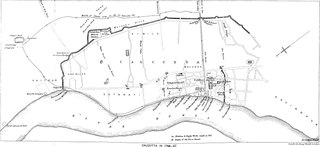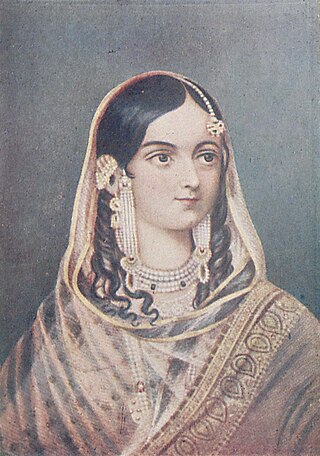
The Battle of Plassey was a decisive victory of the British East India Company, under the leadership of Robert Clive, over the Nawab of Bengal and his French allies on 23 June 1757. Robert Clive was paid £1 million by the Jagat Seth family – a rich Indian family business group – to defeat Siraj-ud-Daulah. The victory was made possible by the defection of Mir Jafar, Nawab Siraj-ud-Daulah's commander in chief who was also paid by the Jagat Seths, as well as much of the Bengal Subah's armies being earlier committed against an Afghan invasion led by Ahmad Shah Durrani against the Mughal Empire. The battle helped the British East India Company take control of Bengal in 1772. Over the next hundred years, they continued to expand their control over vast territories in the rest of the Indian subcontinent, including Burma.

Balaji Baji Rao, often referred to as Nana Saheb I, was the 8th Peshwa of the Maratha Confederacy. He was appointed as Peshwa in 1740 upon the death of his father, the Peshwa Bajirao I.

The Nawab of Bengal was the hereditary ruler of Bengal Subah in Mughal India. In the early 18th-century, the Nawab of Bengal was the de facto independent ruler of the three regions of Bengal, Bihar and Orissa which constitute the modern-day sovereign country of Bangladesh and the Indian states of West Bengal, Bihar and Odisha. The Bengal Subah reached its peak during the reign of Nawab Shuja-ud-Din Muhammad Khan. They are often referred to as the Nawab of Bengal, Bihar and Orissa. The Nawabs were based in Murshidabad which was centrally located within Bengal, Bihar, and Odisha. Their chief, a former prime minister, became the first Nawab. The Nawabs continued to issue coins in the name of the Mughal Emperor, but for all practical purposes, the Nawabs governed as independent monarchs. Bengal continued to contribute the largest share of funds to the imperial treasury in Delhi. The Nawabs, backed by bankers such as the Jagat Seth, became the financial backbone of the Mughal court.

Mir Syed Jafar Ali Khan Bahadur, more commonly known as just Mir Jafar, was a commander-in-chief or military general who reigned as the first dependent Nawab of Bengal of the British East India Company. His reign has been considered by many historians as the start of the expansion of British control of the Indian subcontinent in Indian history and a key step in the eventual British domination of vast areas of pre-partition India.

Alivardi Khan was the fourth Nawab of Bengal from 1740 to 1756. He toppled the Nasiri dynasty of Nawabs by defeating Sarfaraz Khan in 1740 and assumed power himself.

Sarfarāz Khān, born Mīrza Asadullāh, was a Nawab of Bengal. Sarfaraz Khan's maternal grandfather, Nawab Murshid Quli Khan of Bengal nominated him as the direct heir to him as there was no direct heir. After Murshid Quli's death in 1727, Sarfaraz ascended to the Masnad (throne) of the Nawab. Sarfaraz's father, Shuja-ud-Din Muhammad Khan, then the Subahdar of Orissa, getting to know it arrived at Murshidabad, the capital of the Nawabs of Bengal with a huge army. To avoid a conflict in the family the dowager Begum of the Nawab asked Shuja-ud-Din to ascend to the Masnad after Sarfaraz abdicated in favour of his father. However, circumstances led Shuja-ud-Din to nominate Sarfaraz as his heir and after Shuja-us-Din's death in 1739, Sarfaraz Khan again ascended to the Masnad as the Nawab of Bengal.
Bargis were a light cavalry mercenary group of Maratha Empire's who indulged in large scale plundering of the countryside of western part of the Bengal Subah for about ten years (1741–1751) during the Maratha invasions of Bengal. Maratha invasions took place almost as an annual event for 10 years.

The Maratha invasions of Bengal (1742–1751), also known as the Maratha expeditions in Bengal, were the frequent invasions by the Maratha forces in the Bengal Subah, after their successful campaign in the Carnatic region at the Battle of Trichinopoly. The leader of the expeditions was Raghoji Bhonsle of Nagpur. The Marathas invaded Bengal five times from April 1742 to March 1751, which caused widespread economic losses in the Bengal Subah.

The Bengal Subah, also referred to as Mughal Bengal, was the largest subdivision of Mughal India encompassing much of the Bengal region, which includes modern-day Bangladesh, the Indian state of West Bengal, and some parts of the present-day Indian states of Bihar, Jharkhand and Odisha between the 16th and 18th centuries. The state was established following the dissolution of the Bengal Sultanate, a major trading nation in the world, when the region was absorbed into the Mughal Empire. Bengal was the wealthiest region in the Indian subcontinent.

Mehar un-Nisa Begum, better known as Ghaseti Begum, was the eldest daughter of Alivardi Khan, Nawab of Bengal, Bihar and Orissa during 1740–1756.
The Battle of Burdwan occurred between the Bengal Subah and the Maratha Confederacy in 1747. After the dismissal of Mir Jafar by Alivardi Khan, an army was amassed to defend against the invading Maratha forces of Janoji Bhonsle at Orissa. Alivardi Khan managed to heavily repulse and defeat the Marathas in this battle.
The First Battle of Katwa occurred between the Bengal Subah and Maratha Confederacy in 1742. The Marathas under Raghoji initially attacked and captured Katwa and Hooghly in Bengal. The Nawab of Bengal Alivardi Khan, using conscripted tribal and peasant levies from Birbhum, responded with a direct attack on the Maratha camp at Katwa from the rear in nightfall and the entire Maratha Army was evacuated out of Bengal on 17 September 1742, believing a much larger force had charged them. The Maratha commander Bhaskar Pant was treacherously killed.
The Second Battle of Katwa occurred between the Bengal Subah and the Maratha Confederacy in 1745.

Mir Habib Isfahani was a warlord who used to be in the employment of the Mughal Subedars (officers) of Bengal, but after being discontent with promotions, went on to aid the Maratha invaders of Bengal and aided in the various Maratha campaigns carried out in Bengal, Bihar, Orissa and adjoining places.
Zain ud-Din Ahmad Khan, also known as Mirza Muhammad Hashim, was an aristocrat from the Nawab of Bengal family and the father of Siraj ud-Daulah, the last independent Nawab of Bengal.
The Third Battle of Katwa occurred between the Nawab of Bengal, Mir Qasim and the British East India Company in 1763. Dissatisfied with Nawab Mir Qasim's administration, the English deposed him in favor of his father-in-law Mir Jafar and officially declared war against Mir Qasim on July 7, 1763. The English command was given to Major Thomas Adams, who led a small force, variously estimated as between 3,000 and 5,000 men, of whom, approximately 1,000 were European. The Nawab had a total of approximately 25,000 troops at his disposal, led by the Armenian general Gurgin Khan. Although the Nawab's forces were numerically larger, they were hastily cobbled together and riven by internal strife. The Nawabi force that confronted the English at Katwa was a much smaller contingent under the leadership of the accomplished general Muhammad Taqi Khan, the Faujdar of Birbhum.

Jagat Seth was a wealthy merchant, banker and money lender family from Murshidabad in Bengal during the time of the Nawabs of Bengal.
Bhaskar Ram Kolhatkar, known as Baba Bhaskar Pandit or Bhaskar Pant by the people of Bengal and Maharashtra, was a Maratha general and statesman. He was the dewan of the Maharaja of Nagpur, Raghuji Bhonsle. He played an important role in the kingdom of Nagpur's expansion. The first Maratha invasion of Bengal in 1741, as also the third in 1744, was led by him. He was an able military leader, proven by his success in the Maratha invasions of Bengal and conquest of Chhattisgarh. He was killed by Alivardi Khan on 30 March 1744.

Mirza Agha Muhammad Baqer was an aristocrat of the Mughal Empire and the Zamindar of Buzurg-Umedpur and Salimabad. In the Mughal period, these two parganas were spread over a large part of the greater Barisal region. Baker was the son-in-law of Murshid Quli Khan II, the Naib Nazim of Orissa under Nawab Sarfaraz Khan. Baqer had an important role in the conflict between Tabrizi and Alivardi Khan regarding the inheritance of Orissa's Naib Nazimate. He also founded the port marketplace of Bakerganj, which later became the headquarters of the Backergunge District. The legendary origin of the Bakarkhani bread is also attributed to him.
The confrontation between the subahdar of Bengal Subah and the allied forces of Afghans and Marathas in 1748 is known as the Battle of Rani Sarai or Battle of Kaladiara.










